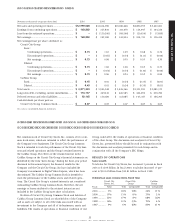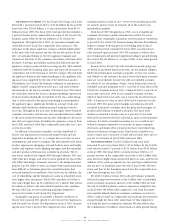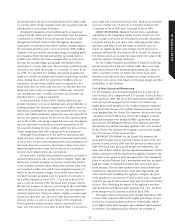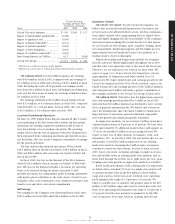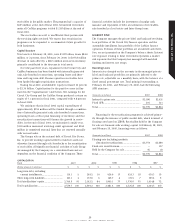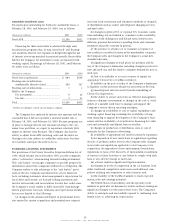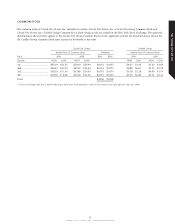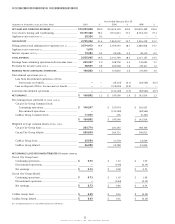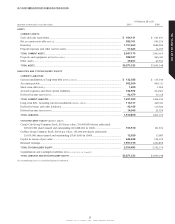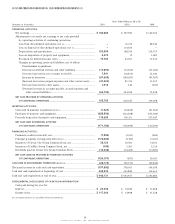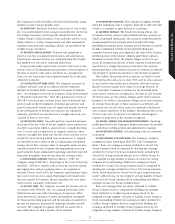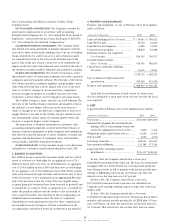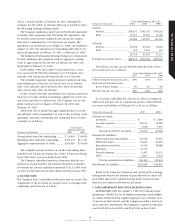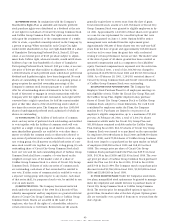CarMax 2001 Annual Report Download - page 33
Download and view the complete annual report
Please find page 33 of the 2001 CarMax annual report below. You can navigate through the pages in the report by either clicking on the pages listed below, or by using the keyword search tool below to find specific information within the annual report.
Automobile Installment Loans
Total principal outstanding for fixed-rate automobile loans at
February 28, 2001, and February 29, 2000, was as follows:
(Amounts in millions) 2001 2000
Fixed APR.............................................................. $1,296 $932
Financing for these receivables is achieved through asset
securitization programs that, in turn, issue fixed- and floating-
rate securities. Interest rate exposure is hedged through the use
of interest rate swaps matched to projected payoffs. Receivables
held by the Company for investment or sale are financed with
working capital. Financings at February 28, 2001, and February
29, 2000, were as follows:
(Amounts in millions) 2001 2000
Fixed-rate securitization ..................................... $ 984 $559
Floating-rate securitizations
synthetically altered to fixed........................ 299 327
Floating-rate securitizations............................... 1 1
Held by the Company:
For investment*................................................ 9 22
For sale............................................................. 3 23
Total........................................................................ $1,296 $932
* Held by a bankruptcy remote special purpose company.
The Company has analyzed its interest rate exposure and has
concluded that it did not represent a material market risk at
February 28, 2001, and February 29, 2000. Because programs are
in place to manage interest rate exposure relating to the con-
sumer loan portfolios, we expect to experience relatively little
impact as interest rates fluctuate. The Company also has the
ability to adjust fixed-APR revolving cards and the index on
floating-rate cards, subject to cardholder ratification, but does
not currently anticipate the need to do so.
FORWARD-LOOKING STATEMENTS
The provisions of the Private Securities Litigation Reform Act of
1995, which became law in December 1995, provide companies
with a “safe harbor” when making forward-looking statements.
This “safe harbor” encourages companies to provide prospective
information about their companies without fear of litigation. The
Company wishes to take advantage of the “safe harbor” provi-
sions of the Act. Company statements that are not historical
facts, including statements about management’s expectations for
fiscal 2002 and beyond, are forward-looking statements and
involve various risks and uncertainties. Factors that could cause
the Company’s actual results to differ materially from manage-
ment’s projections, forecasts, estimates and expectations include,
but are not limited to, the following:
(a) changes in the amount and degree of promotional inten-
sity exerted by current competitors and potential new competi-
tion from both retail stores and alternative methods or channels
of distribution such as online and telephone shopping services
and mail order;
(b) changes in general U.S. or regional U.S. economic condi-
tions including, but not limited to, consumer credit availability,
consumer credit delinquency and default rates, interest rates,
inflation, personal discretionary spending levels and consumer
sentiment about the economy in general;
(c) the presence or absence of, or consumer acceptance of,
new products or product features in the merchandise categories
the Company sells and changes in the Company’s actual mer-
chandise sales mix;
(d) significant changes in retail prices for products sold by
any of the Company’s businesses, including changes in prices for
new and used cars and the relative consumer demand for new or
used cars;
(e) lack of availability or access to sources of supply for
appropriate Circuit City or CarMax inventory;
(f) inability on the part of either of the Company’s businesses
to liquidate excess inventory should excess inventory develop;
(g) unanticipated adverse results from the remodeling of
Circuit City Superstores;
(h) the ability to attract and retain an effective management
team in a dynamic environment or changes in the cost or avail-
ability of a suitable work force to manage and support the
Company’s service-driven operating strategies;
(i) changes in availability or cost of capital expenditure and
working capital financing, including the availability of long-
term financing to support development of the Company’s busi-
nesses and the availability of securitization financing for credit
card and automobile installment loan receivables;
(j) changes in production or distribution costs or cost of
materials for the Company’s advertising;
(k) availability of appropriate real estate locations for expansion;
(l) the imposition of new restrictions or regulations regarding
the sale of products and/or services the Company sells, changes
in tax rules and regulations applicable to the Company or its
competitors, the imposition of new environmental restrictions,
regulations or laws or the discovery of environmental conditions
at current or future locations or any failure to comply with such
laws or any adverse change in such laws;
(m) adverse results in significant litigation matters;
(n) changes in levels of competition in the car business from
either traditional competitors and/or new nontraditional com-
petitors utilizing auto superstore or other formats; and,
(o) the inability of the CarMax business to reach expected
mature sales and earnings potential.
The United States retail industry and the specialty retail
industry in particular are dynamic by nature and have undergone
significant changes over the past several years. The Company’s
ability to anticipate and successfully respond to continuing chal-
lenges is key to achieving its expectations.
30
CIRCUIT CITY STORES, INC. 2001 ANNUAL REPORT





